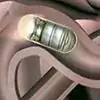Hydrasek
Hydrasek: instructions for use and reviews
- 1. Release form and composition
- 2. Pharmacological properties
- 3. Indications for use
- 4. Contraindications
- 5. Method of application and dosage
- 6. Side effects
- 7. Overdose
- 8. Special instructions
- 9. Application during pregnancy and lactation
- 10. Use in childhood
- 11. In case of impaired renal function
- 12. For violations of liver function
- 13. Drug interactions
- 14. Analogs
- 15. Terms and conditions of storage
- 16. Terms of dispensing from pharmacies
- 17. Reviews
- 18. Price in pharmacies
Latin name: Hidrasek
ATX code: A07XA04
Active ingredient: racecadotril (Racecadotril)
Manufacturer: Sophartex (France)
Description and photo update: 2019-11-07
Prices in pharmacies: from 210 rubles.
Buy

Hydrasek is a drug used for the symptomatic treatment of diarrhea.
Release form and composition
Dosage form - capsules: hard gelatinous, light yellow, size No. 2, the capsules contain white powder with a characteristic odor (in a cardboard box 1 or 2 blisters of 10 capsules and instructions for use of Hydrasek).
Composition of 1 capsule:
- active substance: racecadotril - 100 mg;
- auxiliary components: magnesium stearate - 4 mg; lactose monohydrate - 41 mg; pregelatinized corn starch 78 mg colloidal silicon dioxide - 2 mg;
- capsule shell: titanium dioxide (E171) - 2%; yellow dye iron oxide (E172) - 0.1%; gelatin - up to 100%.
Pharmacological properties
Pharmacodynamics
Racecadotril - the active ingredient Hydrasec is a prodrug that is hydrolyzed to form thiorphan. It is an active metabolite that inhibits enkephalinase, a surface peptidase (which is located on the cell membrane) located in various tissues, especially in the epithelial tissues of the small intestine. The enzyme enkephalinase is required for the hydrolysis of exogenous peptides and the degradation of endogenous peptides such as enkephalins. Thus, racecadotril protects endogenous enkephalins, which exhibit physiological activity at the level of the digestive tract, and prolongs their antisecretory effect.
As an intestinal antisecretory agent, racecadotril has a targeted effect on the reduction of intestinal hypersecretion of water and electrolytes caused by inflammation or cholera enterotoxin. The substance has no effect on the basal secretion of the intestine.
When conducting clinical studies, it was found that the incidence of secondary constipation when taking racecadotril does not differ from that when using placebo.
Racecadotril, having a rapid antidiarrheal effect, does not affect the time of passage of intestinal contents through the intestines and does not lead to bloating.
Pharmacokinetics
Racecadotril is rapidly absorbed after oral administration. The time required for the onset of inhibition of plasma enkephalinase is 30 minutes.
Food intake has no effect on the bioavailability of the substance, but if the drug is used after eating, its activity manifests itself with a delay of about 90 minutes.
After taking racecadotril labeled with a radioactive isotope 14 C, the plasma content of the substance is many times higher than its content in blood cells and 3 times higher than in whole blood. Thus, the drug binds to blood cells only slightly. In other tissues of the body, radiocarbon is moderately distributed, as evidenced by the apparent V d (volume of distribution) in plasma. Up to 90% of thiorphan binds to plasma proteins, mainly albumin.
The pharmacokinetic properties of the substance do not change as a result of taking repeated doses, as well as when used by elderly patients.
The effectiveness and duration of the provided action depends on the dose. The time to peak inhibition of plasma enkephalinase in adult patients is approximately 2 hours. The total time of inhibition of plasma enkephalinase is about 8 hours.
The biological T 1/2 (half-life) of racecadotril (corresponds to the time of inhibition of plasma enkephalinase) is approximately 3 hours.
Racecadotril is hydrolyzed to thiorphan rapidly, and later thiorphan is transformed into inactive metabolites. With repeated administration of the drug, its accumulation in the body does not occur. Racecadotril / Thiorphan and the four major inactive metabolites of the CYP enzyme isoform (3A4, 2D6, 2C9, 1A2, and 2C19) are reportedly not clinically significant. Also, to a clinically significant degree, they do not induce conjugated enzymes UGTs (uridine glucuronosyl transferase) and cytochrome CYP isoforms (3A, 2A6, 2B6, 2C9 / 2C19, 1A, 2E1).
Racecadotril does not affect the protein binding of the following active substances: warfarin, tolbutamide, niflumic acid, phenytoin, digoxin.
The kinetic profile of the active metabolite racecadotril in liver failure (according to the Child-Pugh classification - class B), in comparison with the values of these indicators in healthy people, demonstrates similar indicators of T 1/2 and T max (time to reach maximum concentration) in the blood and lower indicators C max (maximum concentration of the substance) in the blood and AUC (area under the curve "concentration - time") (65 and 29%, respectively).
The kinetic profile of the active metabolite racecadotril in severe renal failure (in patients with creatinine clearance of 11–39 ml / min), in comparison with healthy volunteers, demonstrates a lower C max and higher AUC and T 1/2.
C max after taking the drug is reached after 2 hours 30 minutes.
With repeated use of Hydrasek every 8 hours for 7 days, no cumulation is observed.
Excretion of racecadotril from the body is carried out in the form of metabolites (active and inactive) mainly through the kidneys, with feces - to a much lesser extent. A small fraction of the dose is excreted through the lungs.
Indications for use
Hydrasek is prescribed for the symptomatic treatment of acute diarrhea.
Contraindications
Absolute:
- lactase deficiency, congenital galactose intolerance, glucose-galactose malabsorption syndrome;
- pregnancy and lactation;
- age up to 18 years;
- individual intolerance to the components of the drug.
Relative (use of Hydrasek requires caution): renal failure and / or hepatic failure.
Hydrasek, instructions for use: method and dosage
Hydrasek capsules are taken orally.
The first capsule can be taken regardless of the time of day. In the future, the drug is taken three times a day before meals, 1 capsule.
The therapy is carried out until the stool is normalized (the appearance of at least twice normal feces), but no longer than 7 days. Long-term use of Hydrasec is not recommended.
Side effects
During therapy, the following adverse events may develop [> 10% - very often; (> 1% and 0.1% and 0.01% and <0.1%) - rarely; <0.01% - very rare]:
- skin and subcutaneous tissues: infrequently - erythema, skin rash; with an unknown frequency - toxic dermatitis, polymorphic erythema, edema of the eyelids, face, tongue, lips, urticaria, angioedema, papular rash, erythema nodosum, pruritus, prurigo;
- nervous system: often - headache.
Overdose
At present, isolated cases of racecadotril overdose have been reported without the development of adverse events.
A single dose, corresponding to a 20-fold therapeutic dose, did not lead to side effects.
special instructions
Therapy with Hydrasek does not relieve you of oral rehydration if necessary.
Symptoms of an invasive bacterial infection or other serious illness causing diarrhea may include pus / bloody stool and fever. This is the basis for etiotropic treatment (including antibiotics) or further research. In these conditions, the use of racecadotril as monotherapy is contraindicated. Hydrasek can be used in combination with antibiotics as an additional drug.
Hydrasek capsules are not recommended for the treatment of chronic and antibiotic-associated diarrhea.
With repeated vomiting, the bioavailability of racecadotril may decrease.
Application during pregnancy and lactation
Hydrasek is not prescribed during pregnancy / lactation.
There is no information on the use of racecadotril by pregnant women, sufficient to determine the safety and efficacy of the drug during these periods of a woman's life. In animal studies, racecadotril had no direct / indirect adverse effect on the course of pregnancy, embryonic development, childbirth or postpartum development.
Pediatric use
For patients under 18 years of age, Hydrasek is not prescribed.
With impaired renal function
The use of Hydrasek in renal failure requires caution.
For violations of liver function
The use of Hydrasek in hepatic failure requires caution.
Drug interactions
There is no information on the interaction of Hydrasec with other substances / drugs.
Loperamide or nifuroxazide, used simultaneously with racecadotril, have no effect on the kinetics of the latter.
Analogs
The analogues of Hydrasek are Diasec, Diarex-Himalaya, Imodium Express, Entoban, Vero-Loperamide, Diara, Lopedium, Loperamide, etc.
Terms and conditions of storage
Store at temperatures up to 25 ° C. Keep out of the reach of children.
The shelf life is 3 years.
Terms of dispensing from pharmacies
Dispensed by prescription.
Reviews about Hydrasek
In a few reviews of Hydrasek, patients note that the drug has a rapid antidiarrheal effect.
Price for Hydrasek in pharmacies
Approximate price for Hydrasek, 100 mg capsules, 10 pcs. in the package is 329-484 rubles.
Hydrasek: prices in online pharmacies
|
Drug name Price Pharmacy |
|
Hydrasek 100 mg capsule 10 pcs. 210 RUB Buy |
|
Hydrasek caps. 100mg. No. 10 469 r Buy |

Maria Kulkes Medical journalist About the author
Education: First Moscow State Medical University named after I. M. Sechenov, specialty "General Medicine".
Information about the drug is generalized, provided for informational purposes only and does not replace the official instructions. Self-medication is hazardous to health!







